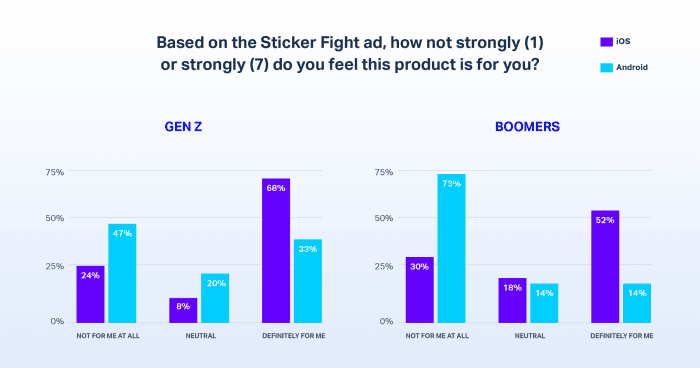Apple is known for its revolutionary and successful advertising campaigns, such as the Think Different campaign of the 1990s and the Get a Mac campaign of the 2000s. But does the company’s recent series of iPhone ads—which reflect a departure from the crisp aesthetics and focus of past ads—succeed in their apparent attempts to court Android users, or simply solidify brand loyalty? It depends on who you ask.
The new ads feature confusing situations, fast cuts, and saturated colors. Apple is thinking different again, but this time intentions may have confused a large segment of users.
UserTesting, the on-demand human insights platform, studied the impact the ads have on consumer sentiment and preferences in the 2018 CX Study: Apple iPhone Ads. The report captures the reactions of 200 iPhone (iOS) and Android customers—broken into Gen Z (18-25) versus Baby Boomers (55+) age groups—to three recent iPhone ads: Sticker Fight, Unlock, and Fly Market.
UserTesting found brand loyalty starts at a very early age, and appears quite difficult to change. In addition, while Apple may be intentionally catering to their youngest demographics, the ads actually deterred Boomers, potentially harming brand perception with older iPhone and Android customers alike.
Smartphone loyalty begins early.
Most customers expressed a strong preference for the devices they currently own. Interest in the iPhone ads or in purchasing an iPhone after viewing an ad strictly followed brand loyalties. Android customers of all ages were less likely to be interested in the iPhone ads and features, while iOS customers across age groups showed significantly more interest.
iPhone ads are for young people.
Many iOS and Android customers in the Boomer age group felt the ads weren’t aimed at them, but rather at a much younger audience—possibly even younger than Gen Z. Boomers called them “silly” and “chaotic.” Even Android customers in the Gen Z age group were more receptive to the ad content.

Ads elicit science fiction fears for Boomers.
Apple’s face recognition technology created discomfort and concerns with privacy and security among many older customers. For some, it elicited fears like being tracked by ads on the subway (a la Minority Report). For instance, a female iPhone customer, age 54 remarked when viewing the FlyMarket ad that, “The thought of paying with a glance scares me. There are a lot of variables to consider.”
It is clear that smartphone brand loyalty starts early and is difficult to change, so it’s likely that Apple is marketing the latest iPhones to consumers even younger than those in this CX study: teens and pre-teens. The company’s age-based approach appears to be paying off. In a 2018 survey, Piper Jaffray found 84% of U.S. teens expect to get an iPhone as their next phone, up from 65% in 2014.
However, if the ads are also intended to convert Android customers or educate older iPhone customers about using cool new features, Apple appears to have fallen from its intended tree.



